Is that a 4CV style heater on the Dauphine above? 

You are using an out of date browser. It may not display this or other websites correctly.
You should upgrade or use an alternative browser.
You should upgrade or use an alternative browser.
1959 4cv Restoration in North Carolina USA
- Thread starter Stan W
- Start date
Yes, that is a 4cv syle heater. According to the article in the front of my ETAI Dauphine book, the Sofica was fitted to Dauphines to from May 1957. Before that, they had the old 4cv type heater. Today I picked up my wheels and manifold from the sandblaster and received a CD in the post with several 4cv manuals including the parts book PR685.Is that a 4CV style heater on the Dauphine above?
I found out that I don't need to do anything special for the charge light when using the Delco 10SI alternator. There is a terminal on the alternator for that, all I have to do is use a 12v bulb. I am also considering variable voltage convertors for the wipers and heater. I can buy these for around $5USD and it will give me whatever speed I like. These convertors use PWM (pulse width modulation) to give different voltages. Resistors would work fine for wipers and heater, but figuring out the resistance is a trial and error process since the impedance of the motors change with voltage.
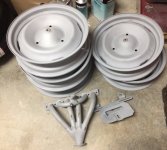
Back to the fuel line subject - the original rubber really was great, thank you for the background information. Those lines stayed put until they got really old, or were taken apart and put back too many times. Generic replacement ones needed clamps.
I'm running a reconditioned SEV Junior in the 4CV - from France and set up properly on a distributor bench. They are a bit prone to bush wear but you'd know all about that. I have a transistorised ignition running off it so that the points switch practically no current. Maybe I get a better spark etc, but honestly I've no idea. The points/capacitor issue was the driver.Yes, that is a 4cv syle heater. According to the article in the front of my ETAI Dauphine book, the Sofica was fitted to Dauphines to from May 1957. Before that, they had the old 4cv type heater. Today I picked up my wheels and manifold from the sandblaster and received a CD in the post with several 4cv manuals including the parts book PR685.I am planning to use the SEV junior distributor that came with the car. I now have extra points and condensers. Is there any problem with using this distributor (other than the lack of vacuum advance)?
I found out that I don't need to do anything special for the charge light when using the Delco 10SI alternator. There is a terminal on the alternator for that, all I have to do is use a 12v bulb. I am also considering variable voltage convertors for the wipers and heater. I can buy these for around $5USD and it will give me whatever speed I like. These convertors use PWM (pulse width modulation) to give different voltages. Resistors would work fine for wipers and heater, but figuring out the resistance is a trial and error process since the impedance of the motors change with voltage.
View attachment 128572
Be nice to have a knob to vary the wiper speed!
The bush is tight in the SEV junior and the lobes don't seem to be worn too unevenly. One lobe seems to give .001" less gap on the points, but I think it will work. The advance mechanism appears to be in good shape. When I get the engine running, I can check the advance on the engine with my timing light. It isn't as accurate as a bench test with proper equipment, but it should let me know if it is close. Today I cleaned and partially disassembled the starter. All appeared good, so I will clean, lubricate and reassemble.
Wow. Tight bush! You can be lucky.... It's not exactly a high performance engine so at one level "near enough is good enough". It always does remind me of the old adage that most carburettor problems are electrical though.The bush is tight in the SEV junior and the lobes don't seem to be worn too unevenly. One lobe seems to give .001" less gap on the points, but I think it will work. The advance mechanism appears to be in good shape. When I get the engine running, I can check the advance on the engine with my timing light. It isn't as accurate as a bench test with proper equipment, but it should let me know if it is close. Today I cleaned and partially disassembled the starter. All appeared good, so I will clean, lubricate and reassemble.
I received my NOS condensers for the SEV jr. today! I already have two nice sets of NOS points. One thing I learned with my MGAs is that new reproduction points, condensers, rotors can be defective or unreliable. Some are good, some are poorly made. The bad ones have soft plastic for the distributor cam follower and some of the rotors have too much carbon in the plastic and do not work at all. I attached a picture of my distributor with the new condenser.
On another subject, the autobleu manifold is really made for a 28mm carburetor and a reducer is used for the 4cv 22mm carb. The mounting holes on the manifold are oblong. A 32mm carburetor could be bolted to the autobleu, but the intake bore is only 29mm.
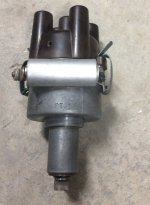
On another subject, the autobleu manifold is really made for a 28mm carburetor and a reducer is used for the 4cv 22mm carb. The mounting holes on the manifold are oblong. A 32mm carburetor could be bolted to the autobleu, but the intake bore is only 29mm.

Yes, that's good. There are quite a lot of NOS parts that are not as good as the original in our experience too. One new part that is better than original is the head gasket! The old copper ones leak modern coolant through the middle layer.I received my NOS condensers for the SEV jr. today! I already have two nice sets of NOS points. One thing I learned with my MGAs is that new reproduction points, condensers, rotors can be defective or unreliable. Some are good, some are poorly made. The bad ones have soft plastic for the distributor cam follower and some of the rotors have too much carbon in the plastic and do not work at all. I attached a picture of my distributor with the new condenser.
On another subject, the autobleu manifold is really made for a 28mm carburetor and a reducer is used for the 4cv 22mm carb. The mounting holes on the manifold are oblong. A 32mm carburetor could be bolted to the autobleu, but the intake bore is only 29mm.
View attachment 128619
I got the engine block back from being welded today! They said it welded like wine and cheese (being French)  . In other words, they didn't have any trouble at all with the metal, but it took some time. There are a lot of shops with talented people around this part of North Carolina. I had a small piece of phenolic sheet laying around, so I made some carburetor spacers for the 28 IBT. I will take the head, block, and crankshaft to the machine shop after Christmas.
. In other words, they didn't have any trouble at all with the metal, but it took some time. There are a lot of shops with talented people around this part of North Carolina. I had a small piece of phenolic sheet laying around, so I made some carburetor spacers for the 28 IBT. I will take the head, block, and crankshaft to the machine shop after Christmas.
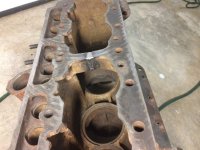

Nice. Have an excellent Christmas!I got the engine block back from being welded today! They said it welded like wine and cheese (being French). In other words, they didn't have any trouble at all with the metal, but it took some time. There are a lot of shops with talented people around this part of North Carolina. I had a small piece of phenolic sheet laying around, so I made some carburetor spacers for the 28 IBT. I will take the head, block, and crankshaft to the machine shop after Christmas.
View attachment 128664
Happy new year! This year will (hopefully) be the first time my 4cv has run in 51 years. I have not been idle over the holidays. I went through the starter, finished painting the gas tank, oil pan and other parts. I finished rebuilding the Dauphine carburetor, made phenolic spacers, modified the manifold to head support to fit the 28mm carb, and fitted the choke hot air pipes to the new carburetor. I took the engine parts to the machine shop, but they are very busy and it will take a few weeks to get to them. I spent a bit of time figuring out the wiring. I have wiring diagrams, but not for the 1959 and later US spec cars.
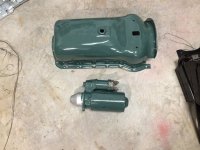
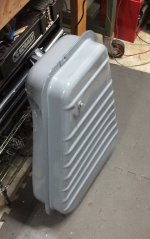
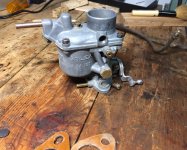
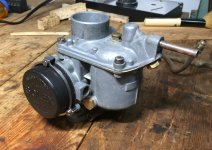
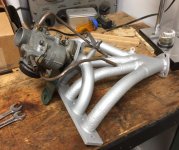





Very nice! Best wishes for 2021.
Nice that the threads are OK on the hot air pipes! Not always the case...
Nice that the threads are OK on the hot air pipes! Not always the case...
I did end up filing the mounting flange and the top casting to get the mating surfaces flat. I got the carburetor body and top within .002", so the gasket should seal fine. One of the hot air pipe threads on the carburetor was slightly cross-threaded, but I got it cleaned up so that the pipe goes on properly. I also polished the choke disc and mating surface to make sure it doesn't stick.
Both typical, but you'd know that! Polishing the disc is a good idea. My 4CV has a manual choke (a Bi-start like yours) and the R8 is hot air automatic but a choke flap and an idle speed accelerator with a curved ratchet ramp and two bimetallic springs. I am certain it works by magic.I did end up filing the mounting flange and the top casting to get the mating surfaces flat. I got the carburetor body and top within .002", so the gasket should seal fine. One of the hot air pipe threads on the carburetor was slightly cross-threaded, but I got it cleaned up so that the pipe goes on properly. I also polished the choke disc and mating surface to make sure it doesn't stick.
My Floride S is the same as early 8 and choke has never worked and car always starts easily with a few pumps of the accelerator. Of course usually not that cold here. Although can be 4 degrees C on a frosty morning but that is very rare, never remember a starting problem though.Both typical, but you'd know that! Polishing the disc is a good idea. My 4CV has a manual choke (a Bi-start like yours) and the R8 is hot air automatic but a choke flap and an idle speed accelerator with a curved ratchet ramp and two bimetallic springs. I am certain it works by magic.
The chokes usually work for decades but yes, the engine is a good starter. It's worse hot than cold actually, as the carb percolates fuel down the accelerator pump tube and it sits in the inlet manifold and makes the mixture too rich to fire. Crack the throttle, hold it steady, and crank until it fires.My Floride S is the same as early 8 and choke has never worked and car always starts easily with a few pumps of the accelerator. Of course usually not that cold here. Although can be 4 degrees C on a frosty morning but that is very rare, never remember a starting problem though.
How have you missed the magic? Clearly you need a fairy.
When my hardware comes out of the rock tumbler, it has to be painted so that it will not rust on the car. Most just gets painted with a rattle can, then baked at around 75 degrees. I made an "oven" out of an old crate that has a hinged lid and a floodlight for the heat. The crate has an interesting history. It started out as a crate of New Zealand peaches that were sent to India in the 1930s. The crate was re-used many times by my grandparents who taught at a Methodist Seminary in India.
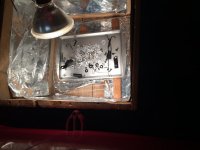
In some distant part of my brain I remembered that the carburetors can be warped, but John gets the credit for bringing it up and reminding me. My first Dauphine had the Zenith carburetor with a choke similar to that described by John on his R8. It always worked perfectly. I had problems with the Solex chokes because I did not know that you have to keep your foot off the gas pedal for it to work!
I figured out that I need a group 26 12v battery to fit in the 4cv battery box.

In some distant part of my brain I remembered that the carburetors can be warped, but John gets the credit for bringing it up and reminding me. My first Dauphine had the Zenith carburetor with a choke similar to that described by John on his R8. It always worked perfectly. I had problems with the Solex chokes because I did not know that you have to keep your foot off the gas pedal for it to work!
I figured out that I need a group 26 12v battery to fit in the 4cv battery box.
I need to construct a PCV system for my engine. I need a vacuum source from the manifold. I was thinking of drilling a hole in the intake manifold below the carburetor. Any thoughts on that?
On my Floride S there is a drilled hole at cylinder 3 intake. On my 12 engine it is opposite cylinder 2 intake. Have no idea why just is.
I think the PCV on the 12 goes to the top of the carby in the gooseneck. Might have a small filter and a restriction in the line too. On my R10 it went into the air filter housing just after the filter. I guess it depends if you want to put oil vapour directly in the engine or through the carby and then in the engine. The VW beetle has the port going in the air filter, which is just an oil bath so it's perfect, the oil stays in the bath, the gas goes through.